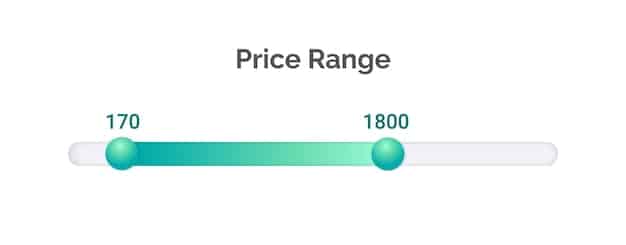Decoding Price History Charts: Finding Real Deals in the US

Decoding Price History Charts: Spotting Real Deals on Price Comparison Sites in the US involves understanding price fluctuations, identifying trends, and using this information to make informed purchasing decisions, ultimately saving money and avoiding overpaying.
Want to snag the best deals online? Decoding Price History Charts: Spotting Real Deals on Price Comparison Sites in the US can help you become a savvy shopper.
Understanding the Basics of Price History Charts
Price history charts are visual representations of a product’s price fluctuations over time. They provide a historical view of how a product’s price has changed, allowing consumers to identify trends, patterns, and potential opportunities to buy at the best possible price.
By understanding how to read these charts, you can avoid impulse purchases and make informed decisions based on actual price trends.
Key Components of a Price History Chart
A price history chart typically displays the following components:
- Time Period: This indicates the duration for which the price history is displayed, ranging from days to years.
- Price Axis: Shows the price range of the product during the specified period.
- Price Line: Represents the actual price of the product at different points in time, forming a line graph.
- Highlight low prices: Identify the historical lowest price through the chart
Understanding these components is crucial for interpreting the chart and making informed purchasing decisions.

Why Use Price Comparison Sites?
Price comparison sites aggregate product listings from multiple retailers, providing a convenient way to compare prices and find the best deals. These sites often include price history charts, enhancing their utility.
Using price comparison sites saves time and effort by consolidating information from various sources into a single platform.
Benefits of Price Comparison Sites
- Comprehensive Price Comparisons: See prices from multiple retailers side-by-side.
- Time-Saving: Avoid manually checking multiple websites.
- Price History Charts: Gain insights into price trends over time.
These benefits make price comparison sites invaluable tools for smart shopping and finding the best deals.
Recognizing Price Patterns
Price history charts reveal common patterns that can inform your purchasing decisions. Recognizing these patterns helps predict future price movements and identify optimal buying times.
Understanding these patterns allows you to strategically time your purchases to maximize savings.
Common Price Patterns to Watch For
Here are some common price patterns to watch for:
- Seasonal Fluctuations: Prices often change based on the season, with discounts common during holidays or clearance events.
- Gradual Declines: Some products experience a slow, steady price decline over time as newer models are released.
- Sudden Price Drops: Keep an eye out for flash sales or promotional periods that cause sudden price drops.
- Spikes After Discounts: Some retailers will artificially increase the price before introducing a discount to make the discount seem bigger than it is.
Being aware of these patterns can empower you to make smarter buying decisions.
Identifying Real Deals vs. Artificial Discounts
Not all discounts are created equal. Some retailers may use tactics to make deals appear better than they actually are. Price history charts can help you distinguish between genuine discounts and artificial ones.
By analyzing historical price data, you can determine whether a current discount is truly significant or just a marketing ploy.

Strategies to Identify Real Deals
Consider these strategies to identify real deals:
- Compare Current Price to Historical Low: Check if the current price is close to the lowest price the product has ever been.
- Look for Consistent Discounts: If a product is always on sale, the “discount” may be the regular price.
- Verify Against Other Retailers: Compare the price with other retailers to see if the discount is unique.
These strategies will help you spot genuine deals and avoid falling for marketing tricks.
Tools and Websites for Tracking Price History
Several tools and websites specialize in tracking price history. These resources offer detailed charts and notifications, making it easier to monitor price changes.
Using these tools streamlines the process of tracking prices and identifying potential deals.
Popular Price Tracking Tools
Consider these popular price tracking tools:
- CamelCamelCamel: Tracks Amazon prices and sends alerts for price drops.
- Honey: A browser extension that automatically finds and applies coupon codes and tracks price history on various sites.
- Keepa: Provides detailed price history charts and price drop alerts for Amazon products.
- Google Shopping: Now tracks the price data of many available online products
These tools can significantly enhance your ability to find the best prices.
Practical Examples of Using Price History Charts
To illustrate the power of price history charts, let’s look at some practical examples of how they can be used to make informed purchasing decisions.
These examples demonstrate the real-world benefits of analyzing price history data.
Scenario 1: Buying Electronics
Suppose you’re interested in buying a new laptop. By consulting a price history chart, you notice that the price typically drops significantly during Black Friday sales in November. Instead of buying the laptop in July at a higher price, you wait until November and purchase it at a substantial discount. So if you wait a little bit, Black Friday, Cyber Monday, and even Amazon Prime Day sales events tend to have limited time deals.
Scenario 2: Purchasing Clothing
Imagine you want to buy a winter coat. A price history chart reveals that the price of winter coats tends to decrease in late winter or early spring as retailers clear out seasonal inventory. By waiting until the end of the season, you can purchase the coat at a reduced price for use the following winter.
Scenario 3: Home Goods Sales
Furniture and home goods have some of the most interesting seasonality. The Summer sales in July, and back to school season in late August will see steep discounts in home goods.
Scenario 4: Avoiding Overpaying
You use a price history chart to verify that a “sale” on a product doesn’t represent a real discount. The chart shows that the current “sale” price is actually higher than the product’s regular price in the past. You decide to wait for a better deal or seek out a different retailer.
These examples highlight the value of price history charts in making informed purchasing decisions and saving money.
| Key Point | Brief Description |
|---|---|
| 📊 Price Charts | Track price changes over time to spot trends. |
| 💰 Real Deals | Identify genuine discounts by comparing historical prices. |
| 🛒 Comparison Sites | Use sites like CamelCamelCamel to find the best prices across retailers. |
| 📅 Seasonal Sales | Wait for seasonal or holiday sales for bigger discounts. |
Frequently Asked Questions
▼
A price history chart is a graph that displays the price fluctuations of a product over a specific period, helping you see price trends and identify potential deals.
▼
Compare the current price to the historical low, look for consistent discounts, and verify the price against other retailers to ensure it’s a genuine deal.
▼
Popular tools include CamelCamelCamel, Honey, and Keepa, which track prices on various sites, send alerts for price drops, and find and apply coupon codes.
▼
Yes, they can. By showing you the historical price data, you can see if the current “discount” is actually a genuine reduction or just a marketing tactic.
▼
Check price history charts regularly, especially when you are considering buying a product. Monitor price trends over days or weeks to identify the best time to buy.
Conclusion
By decoding price history charts: spotting real deals on price comparison sites in the US, consumers can make informed purchasing decisions, save money, and avoid being misled by artificial discounts. With the right knowledge and tools, you can become a savvy shopper and get the best value for your money. Happy shopping!





